15 Email Marketing KPIs Every Marketer Needs to Know

Email marketing is a form of marketing where businesses promote their products or services via email. It is a cost-effective and flexible marketing method that enables you to reach new customers while retaining your old ones.
While this may sound simple in theory, it needs a lot of tweaking in real life.
To avoid common rookie mistakes, you need to learn how to optimize your email marketing campaign for maximum engagement. This involves keeping track of a few basic metrics, also known as Key Performance Indicators (KPIs), to create an effective campaign.
But, before we move ahead, let us understand what a KPI is?
A KPI or Key Performance Indicator is a quantified value that defines the success rate of a business objective. Organizations make use of KPIs at multiple levels to evaluate success rate of
meeting the targets at each level.
To track results of email marketing campaigns, here are 15 metrics or KPIs that help marketers make informed decisions for their future campaigns:
Email Marketing KPIs For Businesses
1. Email Open Rate
In layman’s terms, the email open rate can be described as the number of times your email has been opened. This metric is calculated using the below formula:

It is one of the most basic KPIs used to track how well your subscribers are perceiving your email marketing campaign. It also gives insight into whether you have nailed your subject line copy. You can achieve better success by using the first name of your subscribers as a part of the subject line.
Another strategy to improve your open rate is to keep your subject line short and direct and even add an emoticon or two. The average open rate of most email campaigns is around 24%. If you manage to get a score above that, be assured that you are on the right track and continue with the good work.
2. Click through rate
Your email marketing would be incomplete without a call to action that more often than not involves clicking a link. The email click through rate enables you to find out how many of your subscribers clicked this link. This is often tracked with the help of a tracking domain which is added to the email. When the subscriber clicks the link, they are first taken to the tracking domain before being redirected to the actual destination. The average CTR of an email campaign often depends on the industry.
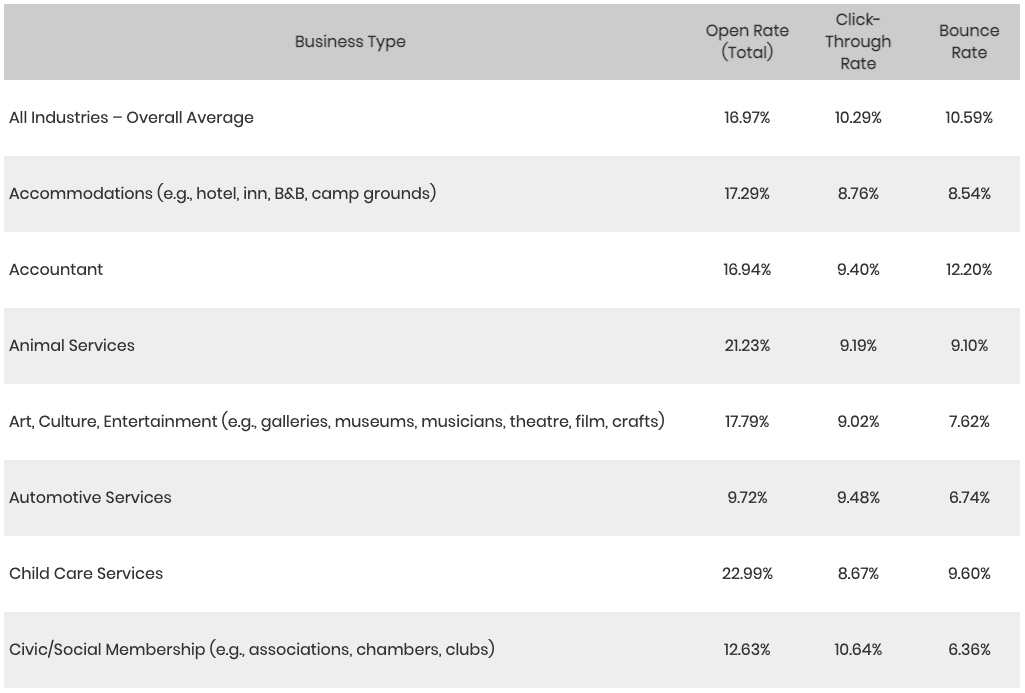
Another interesting fact is that the CTR also varies across the year for seasonal businesses like travel and real estate.
3. Bounce Rate
Inevitably, some of the emails you send out as a part of your email marketing campaign will bounce. The bounce rate is a KPI that offers insight into the deliverability issues of your emails as a result of technical glitches, sender reputation, or even may be due to your email content.
To have a successful email marketing campaign, your bounce rate needs to be as low as possible. This metric can also be used to give you a better idea about your subscriber list. One way of going about achieving a low bounce rate is having a double opt-in option for potential subscribers. This will improve your subscriber list’s quality and lower your bounce rate, a win-win situation all the way. Another thing to note is that the bounce rates tend to differ for different website categories as well.

4. Unsubscribe Rate
This is an important email marketing KPI. Every email marketing engine automatically attaches an ‘unsubscribe’ option to every email sent out to subscribers. This exit strategy will give you an inkling about why subscribers prefer to opt-out of receiving your emails. This is done by asking them to fill out a survey that includes questions about why they would prefer to stop receiving your emails. The ‘unsubscribe’ metric comes in handy to fine-tune your subscriber list.
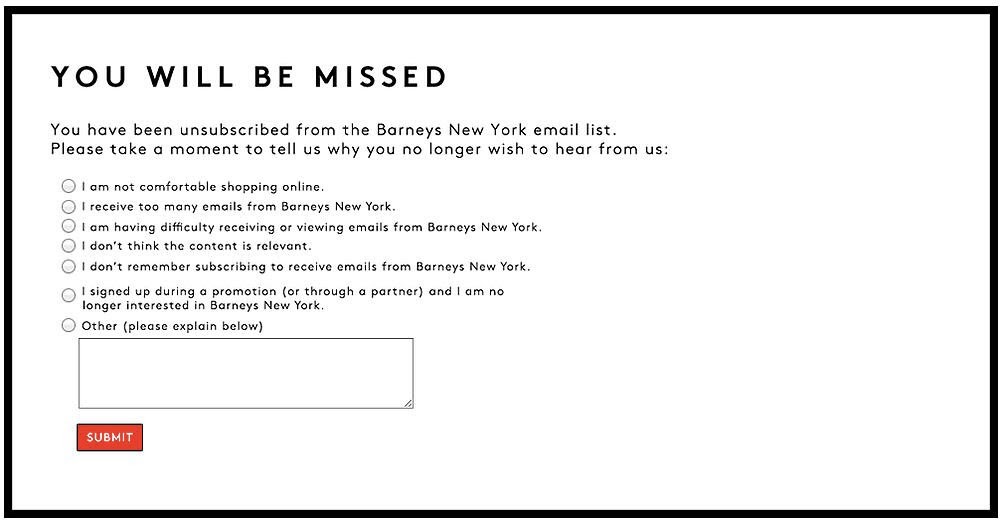
5. Spam Complaint Rate
One of the most discouraging things about running an email marketing campaign is having your email marked as spam. Although it might seem easier to ignore this, you may get in trouble with the email service provider if your spam complaint rate becomes too high. Although the email service provider often tracks this metric, it is a good idea for you to keep an eye on it. Based on this, you can fine-tune your emails and work on improving your subscriber list quality.
6. Click-to-open Rate (CTOR)
The Click-to-open rate is a KPI that evaluates your email’s relevancy and your subscriber list quality. You can rely on this metric to enhance the performance of your email marketing campaign. If your CTOR is on the lower side, you need to tweak your content and email design. CTOR may also be low due to the repetition of email content deterring subscribers from taking action. The CTOR is calculated using the below formula:
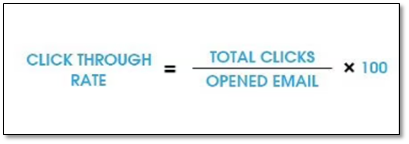
7. Conversion Rate
While CTOR measures how many subscribers clicked on your link, the email marketing conversion rate measures how many people clicked the link and then went ahead to complete a specific action. This KPI gives an insight into your return on investment. Conversion rate is used to measure whether the money you have invested in the email marketing campaign is worth it or not. If the conversion rate is deemed good, you can repeat the campaign in the future.
The actual conversion can be any action determined by your campaign, like placing an order, filling out a form, and so on. As long as the conversion rate is deemed successful, you have a successful email marketing campaign on your hands.
8. Email Signup Rate
The email signup rate is a metric used to measure the number of website visitors who have joined your email list. This email marketing KPI is a clear indicator of whether your landing page encourages visitors to subscribe to your email campaign. In case your sign-up rate remains low, you can try tweaking your landing page and making sure that your website is mobile-friendly as well.
9. Churn Rate
The churn rate metric measures the percentage of subscribers who opt-out of your email subscription in a given period. There are two types of churn rates, namely, transparent and opaque. You need to count the removed contacts from your list to get an accurate churn rate. It is calculated using the below formula:
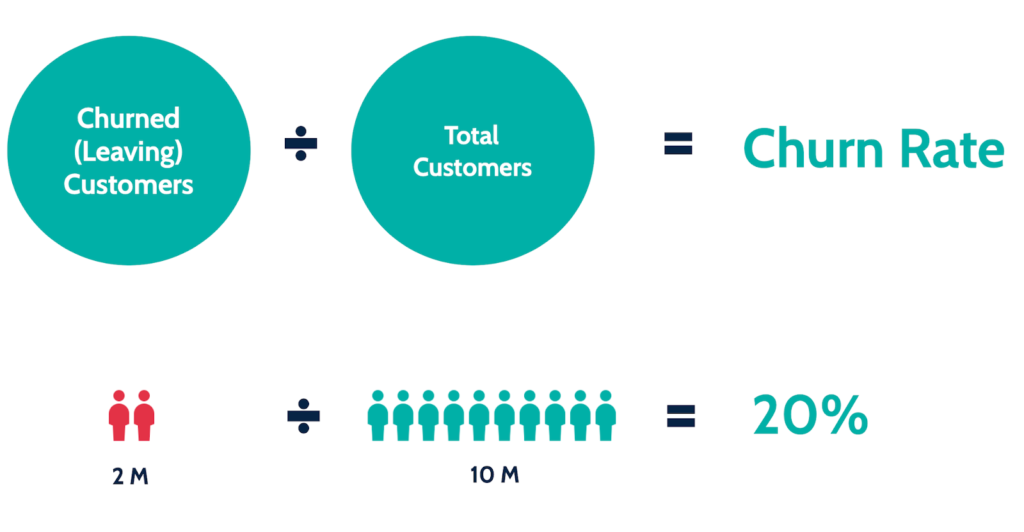
10. List Growth Rate
The list growth rate metric is used to measure the growth rate of your email subscription list. Since attrition is to be expected, you need to continuously grow your list by engaging existing subscribers and finding new subscribers. This KPI is calculated using an easy formula:
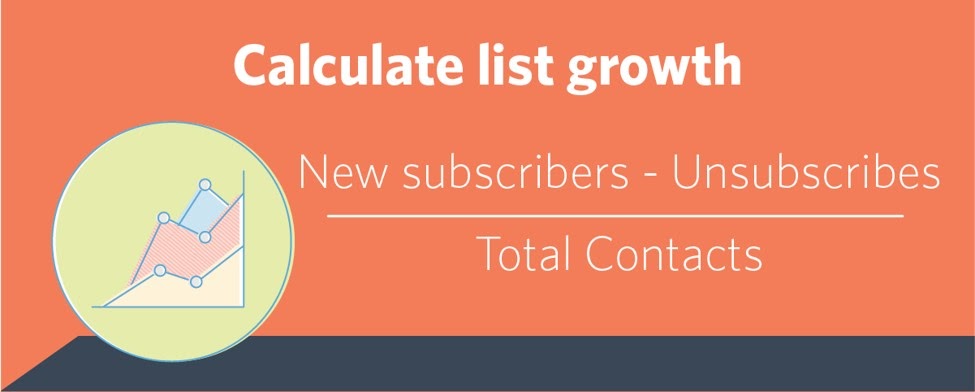
11. Subscriber Retention Rate
The subscriber retention rate metric indicates how many subscribers have opted to stay with you over a while. It is calculated by subtracting the bounces and unsubscribes from the total number of subscribers and dividing it by the total number of subscribers. This KPI gives you an insight into how many subscribers you have retained over some time and how to keep increasing this metric.
12. Average Revenue per Email Sent
This email marketing KPI gives you a clear understanding of how much revenue you stand to make from each email. This KPI is a key part of every email analytics report. However, it is important to remember that all emails are not meant for direct revenue generation. One should not consider the average revenue rate for retention emails and welcome emails when looking at the big picture.
13. Revenue per Open Email
Although revenue per open email is similar to the average revenue per email sent, the former only focuses on the recipients who have opened the email rather than the total number of emails sent out. This KPI identifies the performance of your email marketing campaign. A high revenue per open email is a clear indication that you have a successful email marketing campaign on your hands.
14. Revenue per Subscriber
This metric focuses on the revenue generated from each subscriber rather than the emails. This is another approach to figuring out whether your email marketing campaign has been successful or not. It is calculated using a formula.

15. Email Campaign Profitability
This helps ascertain the profitability of the email campaign you run. Though it can be a challenge to have the exact numbers as there are many variables involved, it nevertheless can give you an idea of whether the campaign was a success or failure. It is calculated as follows:
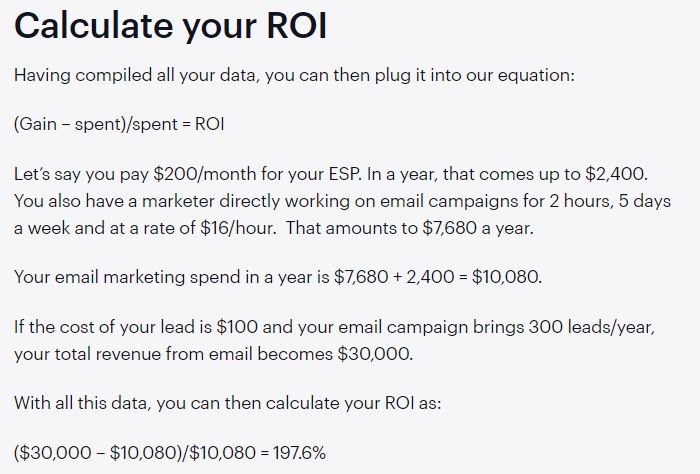
Besides the metric mentioned above, delivery rates are also observed closely to ensure that the marketing campaign is successful.
Vanity metrics like how many people follow you on Instagram do not necessarily convert to revenue. This is why experts recommend sticking to KPIs rather than relying on vanity and actionable metrics to design a successful marketing campaign.
According to the digital marketing industry experts, it is ideal for keeping an eye on all of the metrics mentioned here. These KPIs give you an insight into subscriber behaviors and tweak your campaign accordingly.

FAQs
The most important metric in email marketing is conversion rate. It determines the real-time conversion — action taken via your email links. It could be a subscription, purchase, anything which you asked the audience to act on. It is the number of users who took action out of the total website visitors.
Conversion rate is calculated by dividing the number of actions by the number of emails successfully delivered, multiplied by 100.
The average click-through rate for email marketing is 2.5% according to Campaign Monitor, but the higher, the better. If your click rates are low, you may need to revisit your email content and also your audience list.
A metric that’s closely related to click rate is the click-to-open rate (CTOR). While click rates are calculated on the total number of recipients or emails delivered, the click-to-open rate is calculated on the number of email opens. In other words, the click-to-open rate is the number of clicks as a percentage of the number of opens. The average CTOR is between 20 and 30%. If your CTOR is low, the problem lies primarily in your email content.
Open rates can lie anywhere between 15 and 25% depending on the industry, according to Campaign Monitor.
While having a high open-rate for your email can be a confidence booster, the number can often be deceptive. This is because all it takes for people to open your email is an attractive subject line. If your subject line is short, catchy, has specific keywords or the recipient’s name, people are likely to open the email. However, if they find the email itself irrelevant or uninteresting, they may not take the action you want them to take, and the email becomes useless.
So, why then should you track open rates? Because open rates are a gauge of your content, audience, and also strategy. If your open rates are low, it means your audience is irrelevant, or you’re sending the emails on a wrong day, or you have misjudged the time. If your open rates are high but click rates low, it means you need to sanitize your audience list. If both your open and click rates are high, then congratulations! You have a winner in your hands.
The average unsubscribe rate is around 0.1%. Although a higher unsubscribe rate is undesirable, you needn’t be too concerned about it. It could just be that your mailing list is cleaning itself out of an irrelevant audience.
However, if your unsubscribe rate is consistently high, it’s time you inspected your content and audience list. Or, if it shoots up unexpectedly for one email campaign, analyze if something in your subject line or email body has put off your audience, and avoid it in your next email.
The average bounce rate oscillates between 0.05 and 0.6 for different industries, says MailChimp. Email bounces are usually unavoidable; there are always cases where the email server might be experiencing troubles when you send your blast, some intended recipient might’ve left the organization, and so on.
However, if your bounce rate is high for every email blast, you may need to zoom in to your audience list and weed out non-existent, outdated, invalid addresses. When an email bounces because of such reasons, it is called a hard bounce and should be avoided at all costs because ISPs (Internet Service Providers) judge your reputation based on your hard bounce rate. Soft bounces, on the other hand, happen because of an overloaded email server or even a glitch from your end, are temporary and can be easily rectified.
Latest Blogs
Learn how to rank on AI search engines like ChatGPT, Perplexity, and Gemini by optimizing your content for authority, structure, and relevance. Stay ahead in AI-driven search with this strategic guide.
Explore the best healthcare SEO services for your medical practice. Improve online visibility and effectively reach more patients in need of your services.
Discover top social media agencies specializing in banking solutions, enhancing financial services and driving engagement.
Get your hands on the latest news!
Similar Posts

Email Marketing
6 mins read
11 Tips to Design Impactful Email Banners

Design
9 mins read
7 Benefits of a Simple Mailer Design

Email Marketing
7 mins read